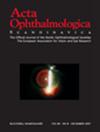A novel artificial intelligence-based classification of highly myopic eyes based on visual function and fundus features
Abstract
Aims/Purpose: To develop a novel classification of highly myopic eyes using artificial intelligence (AI) and investigate its relationship with contrast sensitivity function (CSF) and fundus features.
Methods: 616 highly myopic eyes of 616 patients were enrolled. CSF was measured using the quantitative CSF method. Myopic macular degeneration (MMD) was graded according to the International META-PM Classification. Thickness of the macula and peripapillary retinal nerve fiber layer (p-RNFL) were assessed by fundus photography and optical coherence tomography, respectively. Classification was performed by combining CSF and fundus features with principal component analysis and k-means clustering.
Results: With 83.35% total variance explained, highly myopic eyes were classified into 4 categories. The percentages of categories 1 to 4 were 14.9%, 37.5%, 36.2%, and 11.4%, respectively. CSF of the eyes in category 1 were the highest, followed by those in category 2 and then category 3, while the lowest was seen in category 4. Compared to those in category 1, eyes in category 2 presented higher percentage of MMD2 and thinner temporal p-RNFL. Eyes in categories 3 and 4 presented significantly higher percentage of MMD≥3, thinner nasal macular thickness and p-RNFL (p < 0.05). Multivariate regression showed category 4 had higher MMD grades, thinner macular and p-RNFL thickness compared to category 3.
Conclusions: We proposed an AI-based classification of highly myopic eyes by integrating features from both visual function and fundus. It might be an important tool to comprehensively evaluate highly myopic eyes.

 求助内容:
求助内容: 应助结果提醒方式:
应助结果提醒方式:


